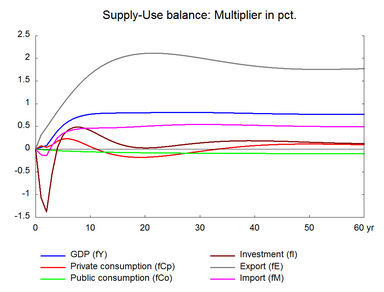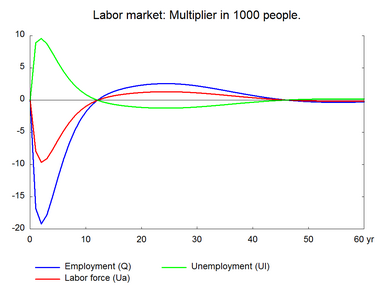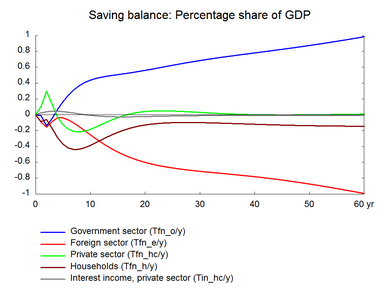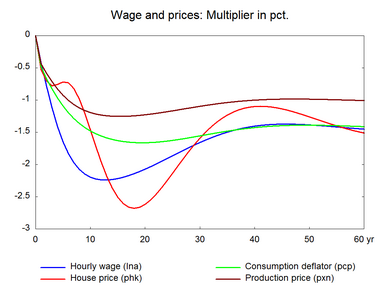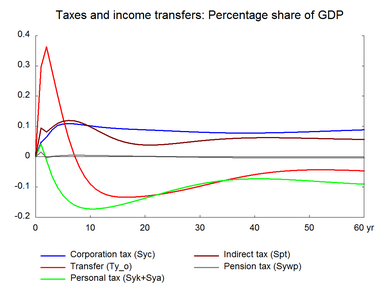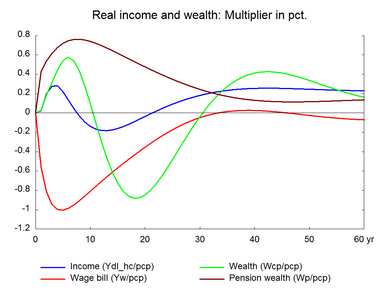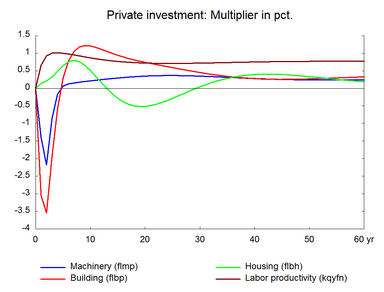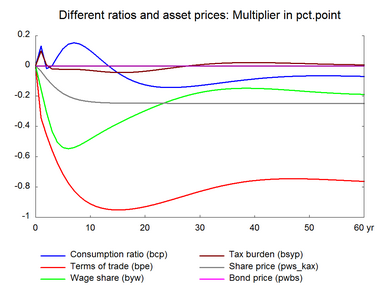Here, the efficiency of capital and labor is increased and the demand for both factors falls. The experiment produces a general reduction in production costs, therefore, a long run gain in foreign trade and domestic production. Table 14 presents the effect of a permanent 1 percent increase in the efficiency of labor and capital.(See experiment)
Table 14. The effect of a permanent increase in labor and capital efficiency
| 1. yr | 2. yr | 3. yr | 4. yr | 5. yr | 10. yr | 15. yr | 20. yr | 25. yr | 30. yr | ||
| Million 2005-kr. | |||||||||||
| Priv. consumption | fCp | 580 | 322 | 742 | 1441 | 1864 | 504 | -1331 | -1851 | -1432 | -584 |
| Pub. consumption | fCo | -38 | -75 | -109 | -140 | -168 | -280 | -367 | -440 | -508 | -573 |
| Investment | fI | -3911 | -4760 | -1962 | 135 | 1143 | 1675 | 547 | 133 | 361 | 752 |
| Export | fE | 2843 | 4447 | 6224 | 7952 | 9699 | 17350 | 22571 | 25735 | 27499 | 28465 |
| Import | fM | -1118 | -1294 | 723 | 2407 | 3373 | 4872 | 5397 | 6187 | 7041 | 7742 |
| GDP | fY | 674 | 1211 | 3912 | 6570 | 8651 | 13624 | 15193 | 16491 | 17903 | 19261 |
| 1000 Persons | |||||||||||
| Employment | Q | -16,82 | -19,20 | -17,82 | -15,03 | -12,01 | -1,83 | 1,32 | 2,31 | 2,54 | 2,19 |
| Unemployment | Ul | 8,89 | 9,55 | 8,73 | 7,31 | 5,81 | 0,85 | -0,67 | -1,14 | -1,25 | -1,08 |
| Percent of GDP | |||||||||||
| Pub. budget balance | Tfn_o/Y | -0,01 | -0,14 | -0,05 | 0,06 | 0,16 | 0,44 | 0,51 | 0,56 | 0,62 | 0,68 |
| Priv. saving surplus | Tfn_hc/Y | 0,10 | 0,30 | 0,14 | -0,03 | -0,13 | -0,18 | -0,04 | 0,04 | 0,05 | 0,03 |
| Balance of payments | Enl/Y | 0,09 | 0,16 | 0,09 | 0,04 | 0,04 | 0,25 | 0,47 | 0,60 | 0,67 | 0,71 |
| Foreign receivables | Wnnb_e/Y | 0,58 | 0,94 | 1,08 | 1,14 | 1,20 | 1,95 | 3,54 | 5,54 | 7,60 | 9,56 |
| Bond debt | Wbd_os_z/Y | 0,30 | 0,50 | 0,55 | 0,49 | 0,35 | -1,15 | -2,98 | -4,75 | -6,51 | -8,25 |
| Percent | |||||||||||
| Capital intensity | fKn/fX | -0,15 | -0,31 | -0,52 | -0,68 | -0,80 | -0,97 | -1,01 | -1,05 | -1,08 | -1,06 |
| Labour intensity | hq/fX | -0,70 | -0,85 | -0,99 | -1,06 | -1,09 | -1,06 | -1,03 | -1,02 | -1,02 | -1,01 |
| User cost | uim | -0,47 | -0,62 | -0,75 | -0,86 | -0,94 | -1,18 | -1,24 | -1,22 | -1,16 | -1,10 |
| Wage | lna | -0,42 | -0,78 | -1,12 | -1,41 | -1,65 | -2,20 | -2,22 | -2,07 | -1,87 | -1,66 |
| Consumption price | pcp | -0,48 | -0,67 | -0,83 | -0,97 | -1,09 | -1,48 | -1,63 | -1,66 | -1,63 | -1,56 |
| Terms of trade | bpe | -0,33 | -0,44 | -0,54 | -0,62 | -0,69 | -0,88 | -0,92 | -0,90 | -0,86 | -0,80 |
| Percentage-point | |||||||||||
| Consumption ratio | bcp | 0,13 | -0,02 | 0,00 | 0,06 | 0,11 | 0,10 | -0,04 | -0,13 | -0,14 | -0,13 |
| Wage share | byw | -0,15 | -0,31 | -0,43 | -0,51 | -0,54 | -0,48 | -0,38 | -0,30 | -0,23 | -0,18 |
Higher efficiency of labor and capital means that both factor inputs can be reduced, consequently investment and employment fall in the short term. The fall, particularly in machinery investment, reduces imports and depreciation, which increases gross operating surplus. As factors efficiency increases prices fall and net exports increase without relying on change in wages. Higher net exports increase production and employment. This offsets the initial fall in employment created by the increase in labor efficiency.
The initial fall in employment pushes wages and prices downward. This improves competitiveness and induce exports to rise even more. As in the previous experiment, the combined effect of higher efficiency and lower wages means that the short-term decrease in factor utilization disappears relatively quickly and the initial negative impact on employment is reversed quickly. In the long term, capital intensity and labor intensity fall by approximately 1 percent, excluding the housing sector.
There is a small positive impact on private consumption in the long run, due to the positive impact on real disposable income, which is stimulated as the higher productivity increases the real income of transfer recipients. The public budget improves in the long term.
Figure 14. The effect of a permanent increase in labor and capital efficiency
